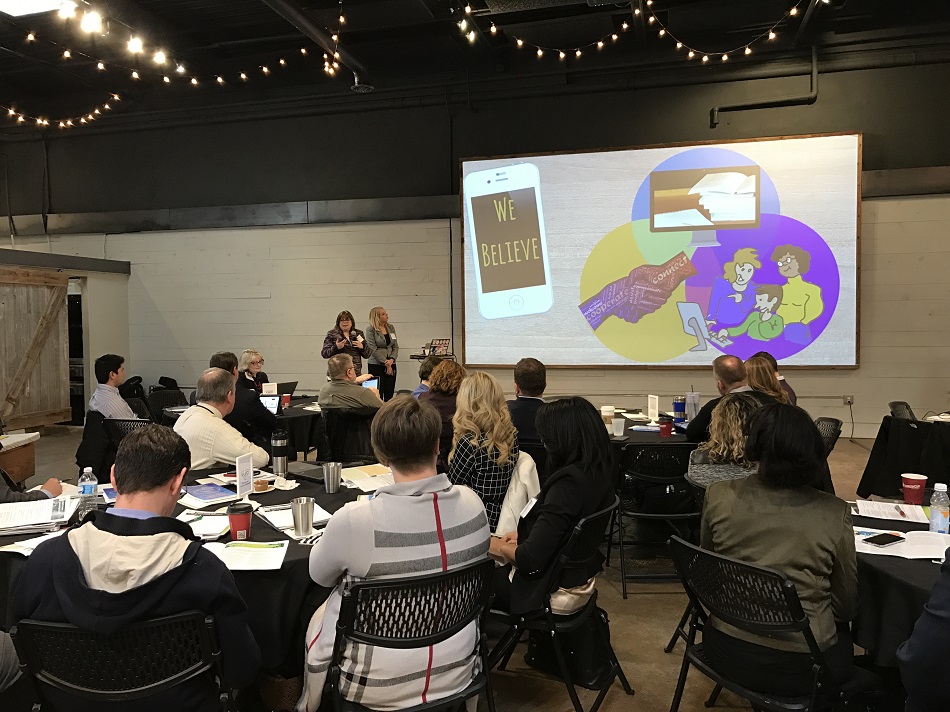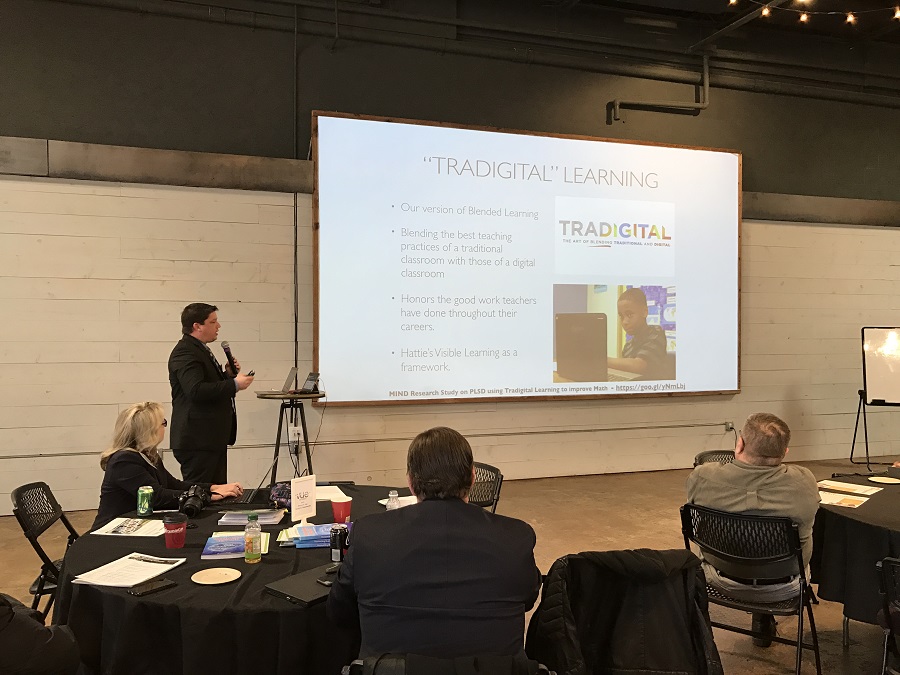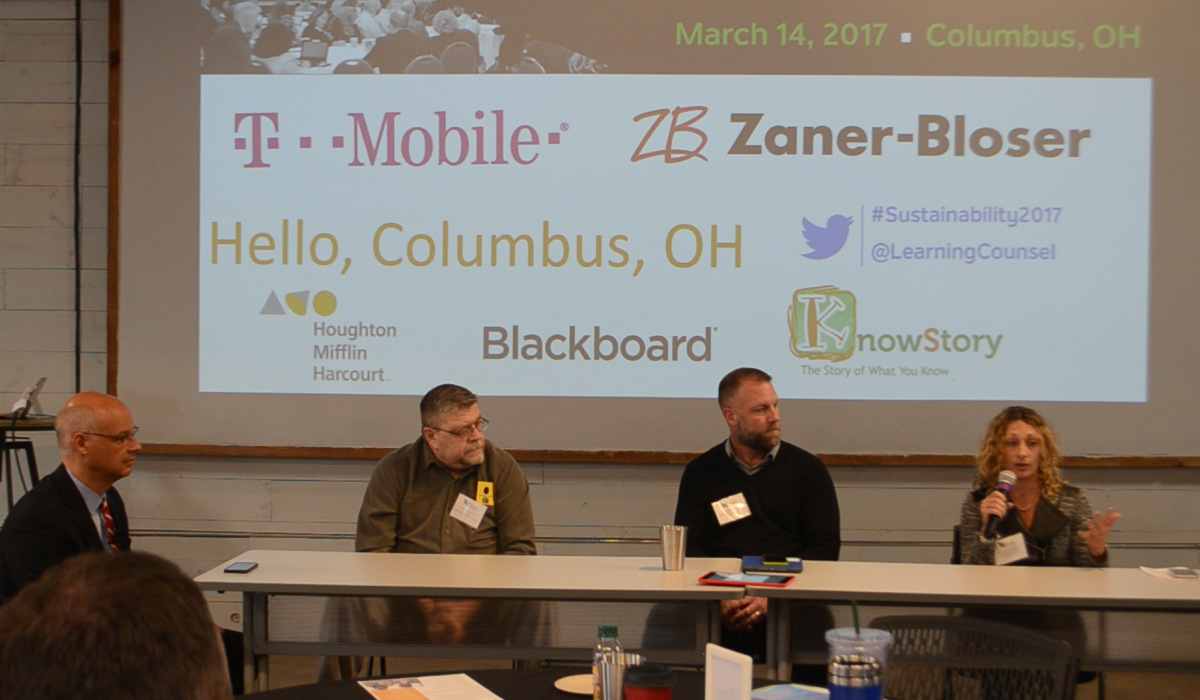Education administrators, instructional technology specialists and teachers gathered in downtown Columbus, OH., in mid-March to hear from the Learning Counsel, to discuss digital curriculum transition strategies and share what is working in their region.
The room included many teams who attended together to be able to collaborate. Teams included: Columbus City Schools, Dayton Public Schools, Hilliard City Schools, Pickerington Schools, Catholic Diocese of Cleveland, MSD of Wayne Township, Jonathan Alder Local Schools, Worthington Adventist Academy and Cincinatti Public Schools.
A sense of what attendees were looking for from the day was gleaned from the “lobby talk” during the morning breakfast and networking time. “We’re hoping to get ideas on how to support our schools moving forward with digital curriculum,” stated Dolores Bruno, Curriculum Integration Specialist from Catholic Diocese of Cleveland. “Our team is here to learn from other districts about tech and the shift to digital curriculum,” Sarah Trimble-Oliver, Chief Information Officer from Cincinnati Public Schools. “We want to share our story and also gather more info about what others are doing,” Mark Pohlman, Director of Instructional Technology from Hilliard City Schools. “We’re here to learn so that we can make intentional decisions about our next steps,” Nicole Schrock, Tech Integration Specialist from Johnathan Alder Schools.
Photo Gallery: Columbus Digital Curriculum Discussion
They got exactly what they came for: The day got off to a fast start with a presentation from the CEO and Publisher of the Learning Counsel, Leilani Cauthen, about the state of the market and what she is finding with schools and districts across the country. “Currently the statistics are showing that 78% of our K-12 students have access to a device for a significant portion of the school day, either through a 1-to-1 initiative or BYOD (bring your own device),” she stated. “That number will raise closer to 85% by the end of this year. Schools are also finding that sharing a device between students and/or keeping the devices locked at schools at the end of the day is not working. What is working is handing the devices over to the students, empowering them with ownership of the technology and access to create their learning path.”
She shared stories from school executives in California and Texas where taking the devices home was the successful way that they decided to support the students and provide them with the tools to go all-in with digital.
As the day progressed, districts shared stories of success, failure and what they’ve learned through these last few years of building up their network infrastructure and retraining teachers to operate technology-centered classrooms. Several executives spoke about their solutions for a complete shift in classroom instruction with devices and software.
Metro School District of Wayne Township Share
As one example of a district share, Michele Eaton and Dana Lile from MSD of Wayne Township in Indianapolis presented their digital curriculum transition story: they have 16,000 students in Pre-K – 12, including 3 high schools, and a full virtual academy. “We wanted to raise everyone up, not just our students but their whole families. Our story began with a very traditional LMS function,” they stated. “Then our tech department moved forward, got the virtual school running out of a new LMS. Teachers could go there to instruct but, to get curriculum, they had to go to another system. So, we had to get ANOTHER new LMS. We were not coordinated and planning strategically for sustainability. Finally we brought both curriculum and tech departments together. We broke down the silos. The first thing we did is create a belief statement—‘what do we believe in?’
“We’re not prescriptive really,” they continued. “We just have units of study guidance and possible activities and pinnacles of what we want. Teachers do love it and use it. We have more than enough Chromebooks in our district and we believe that we should use them. We use our LMS as the learning environment for students, that’s traditional, but we rebranded it to be the Wayne Learning Hub. Our curriculum management is now in the same hub where students are learning, and we have an SSO for everyone. We moved to an itslearning LMS because we wanted to be very intentional for curriculum management and learning in one place. It is transparent and allows students to be collaborative, but as we are moving forward we are adding more student projects for critical thinking. We know we have to do more for our students. We are hopeful for a lot more adoption, and we’ve built curriculum maps for sharing and using by teachers.”
They continued on the situation—that many districts are challenged by—of too many logins. “We know that having a multitude of log-ins across platforms is confusing for students and teachers and it also causes a loss in wide-spread adoption,” They stated. “We’ve partnered with IMS Global to use their standards, like thin common cartridge, to ensure integrations into our systems. There is no easy button, it is not easy work to get things to be useful for teachers systems-wise and integrations-wise. We worked together to create a flowchart to get integrations done easily within our system. What’s important is a lot of cross-department working together to make something happen. To integrate all these things, people have to be on the same page.”
How Pickerington Schools is Getting it Done
Later in the morning, following a leadership exercise to develop strategic thinking (in case of a zombie apocalypse—something any savvy executive may confront)—Pickerington Schools shared their district’s ongoing story of transformation.
Brian Seymour, the Director of Instructional Technology, told the group how his district of 10,000+ students began their shift with a clear strategy. “We built a tech plan and talked about change in pedagogy through the lens of teaching and learning first,” Brian stated. “We have a roadmap for devices for every space, for when we will upgrade for a lab, for instance, or when a teacher gets new devices. Our tech plan is about 120 pages long.
He continued, “Our research shows that the best teaching practice is the blending of a traditional classroom with that of a digital. It honors the good work teachers have done throughout their career. For us it’s really the art of blending traditional and digital. ST math did a 2-year study to show how effective we were in improving our math curriculum. In 2016-2017 we are accelerating the rollout with grades 5 and 6 for 1-to-1. Then we will roll out 5,300 more Chromebooks and additional iPads. (The Chromebooks are really for the upper grades.)
“With blended learning, we are focused on a station rotation model. As we all know, rows of seats and teachers up at the front of the room doesn’t work. Station rotation does work,” Brian stated. “Our teachers practice the 4C’s: Critical Thinking, Communication, Collaboration and Creativity. Station rotation in action is the hard thing to get teachers to move over to. The teachers ‘became kids’ in effect and went thru the different parts of a station rotation model, museum walks, and teacher led parts, and others.
“We got rid of textbooks about 4 years ago so the only ones we buy are for AP courses or college ready courses. Our apps or software has to be aligned to standards, supply usable data, easy to use and engaging.” Brian shared with the group the top education tools they are utilizing: “We are using YouTube, Renaissance, Kahoot, Nitro Type, Vocabulary Spelling City, Infinite Campus, Illuminate, Hapara Nearpod, Moby Max. In terms of classroom management, we needed to create building/district wide common language so we’ve got three levels of Google chrome use, including creating parameters for when tech is used and when it is not.
Mr. Seymour ended with what they are looking at for the future, “We are looking at how other types of software/accessories can help teaching and learning. We have a major investment in VR for our schools, software as an app, how VR can close the achievement gap through better experiences. We have redesigned a lot of our rooms so that they are reinvented and are coming from the idea of our tech plan.”
Pickerington is also using social media to collaborate, run PLNs and share information, particularly Twitter.
The day ended with the traditional executive panel discussion to take Q&A from the audience.










